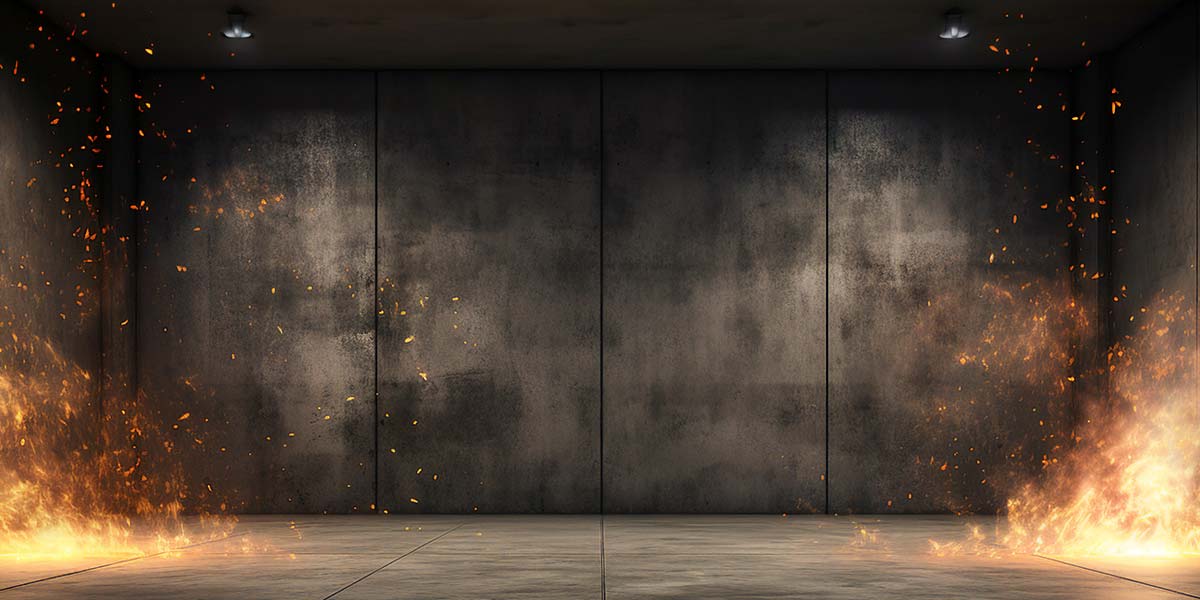
RoboGames 2024
By Camp Peavy View In Digital Edition
I didn’t expect to go to RoboGames 2024, but Dave Calkins (master Event Coordinator and all-around good guy) “says no.” Dave kept talking about Robo-Magellan like I was going to be there. So, after some tough negotiating (he bought me a plane ticket), I was on my way to California for the 16th (sometimes annual) RoboGames — The “Olympics” of Robotics!
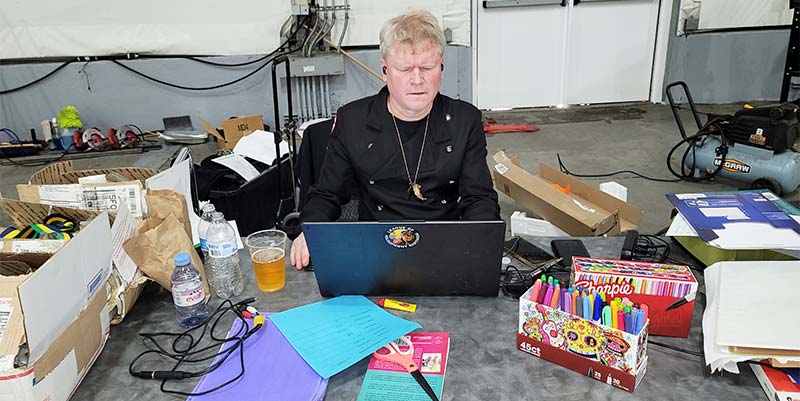
RoboGames founder, Dave “says no” Calkins in his native habitat.
The cool thing is that when I go to Silicon Valley (I live in Florida now), I have a place to stay with my robot-building buddy, John Erickson. John was scrambling to get his agricultural robot (Cyclops) ready for the event. Plus, the Games were at a new venue: the San Jose Convention Center.
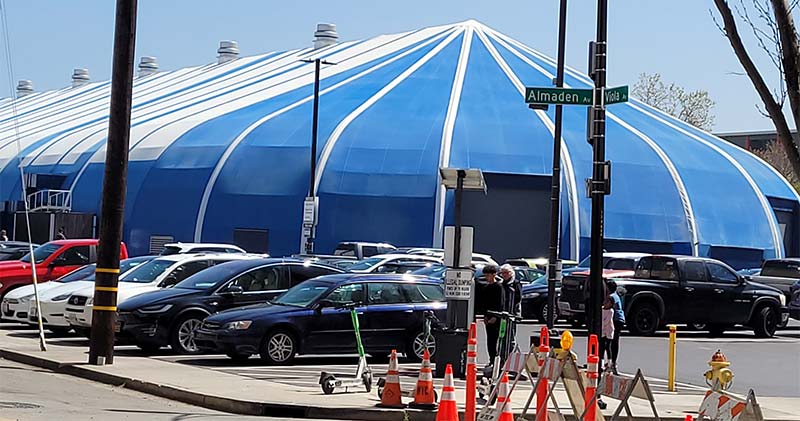
San Jose Convention Center. We walked around the building for an hour before someone directed us to the blue and white striped circus tent.
I arrived in San Francisco on Friday, April 12. RoboGames was held April 19-21. After a day of recovery (jet lag) and setting up a HomeBrew Robotics Club (HBRC) dinner at Pedro’s in San Jose for Wednesday night (April 17th), John and I headed for San Jose (yes, we know the way) and the San Jose Convention Center.
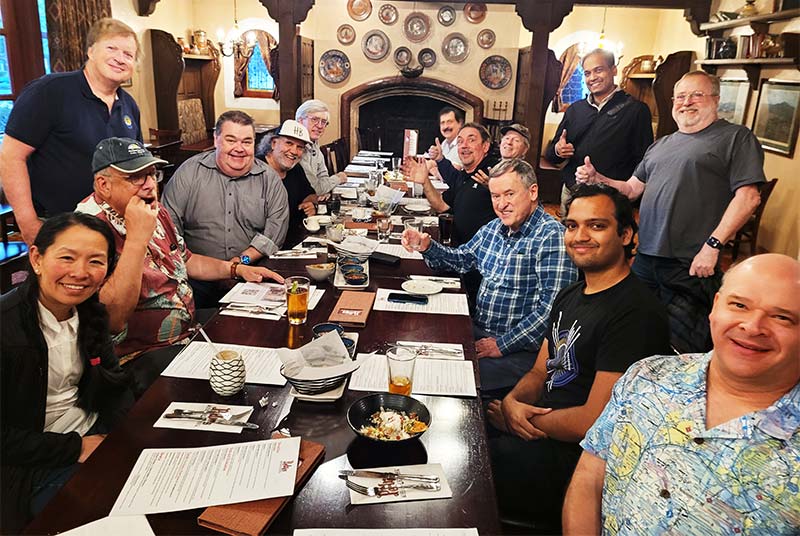
HomeBrew Robotics Club dinner at Pedro’s the night before RoboGames.
The first order of business was to establish the GPS “Goal” for Robo-Magellan. Robo-Magellan is a robotics competition emphasizing autonomous navigation and obstacle avoidance over varied, outdoor terrain.

We held the RoboMagellan event at Discovery Meadow, the park next to the Children’s Discovery Museum, near the mastodon.
Robots have three opportunities to navigate from a starting point to an ending point and are scored on the time required to complete the course, with opportunities to lower the score based on contacting intermediate points. These rules are from the Seattle Robotics Society’s Robo-Magellan event and have been a traditional at RoboGames, of which I’ve coordinated/judged for years.

Jim DiNunzio with the Robotics Society of Southern California was at RoboGames with his voice intelligent robot, Big Orange.
When I first heard the event was at the Convention Center in San Jose, I looked at a Google map and thought, where will they have this? This was my first indication that Dave expected me to be there. I looked at some spaces around the Convention Center, but these were parking lots and would undoubtedly have cars. This is when Dave mentioned the Children’s Discovery Museum of San Jose on Woz Way.
So, on Sunday the 14th (six days before the event), John and I went to Discovery Meadow: the park next to the Children’s Discovery Museum. It was full of kids celebrating the OMG Family Festival. Fortunately, we envisioned having the event to the side and in front of the OMG festival, near the mastodon. Yes, the mastodon.
When we checked the calendar for Saturday (Robo-Magellan day), “Children of the Dragon” was slated for April 19. OMG had quite a crowd, and we didn’t think the Dragon Children crowd could be much bigger. Besides, we were well out of the way (again, near the mastodon), and Robo-Magellan is a spectator-friendly sport.
Having pinpointed the Robo-Magellan Start and Goal GPS coordinates, we were ready for the Games with two days to spare!
That gave us two days of chillin’ with John (still) working feverishly on Cyclops and me regretting not having paid for expedited shipping on my robots (Buggy 3 and Smarty 2).

Smarty 2 is a “smart table.” It’s a tray table that can reliably get from one place to another.
I recalled from last year when one of my robots showed up an hour before the event, and another robot (appropriately named Robot Snail) showed up a day late. That’s me, trying to save a nickel … “expected on Wednesday but not guaranteed.”
On Wednesday the 17th, I visited family and friends in Santa Clara, culminating with the aforementioned dinner at Pedro’s with the HomeBrew Robotics Club (www.hbrobotics.org). The HBRC meets on the last Wednesday of every month (except December) on Zoom and in person at InOrbit in Mountain View, CA.
Oh, and my UPS delivery arrived! Hallelujah!
On the first day of RoboGames (Friday, April 18), John and I parked in the public parking lot for the Hilton/San Jose Convention Center (location H2-8 blue). We must have wandered around the block for an hour before being directed to the blue and white circus tent next to the San Jose Convention Center. A little signage might have been helpful, but once inside, it was clear we were amongst the robot people.
Day 1 is about settling in, setting up, and getting ready. My first event (competing, not judging) was“TableTop Navigation at 5 pm. Both John and I were entered in Best of Show as well: John with Cyclops, his agricultural robot (which unfortunately is still a work-in-progress); and me with Smarty 2, a “MockTurtleBot” that maps and navigates.
For a list of all the events, go to https://robogames.net/events.php.
After checking in and getting our badges, we headed back to the car to get our stuff.

John and I after checking in and getting our badges. Maybe now we’ll get some respect.
We went to the Hilton/San Jose Convention Center public parking (location H2-8 blue), but the car was not there. This was not our first rodeo, so not only did we write down the location where we parked, but we also took pictures! And the car was not there!
After going to the front desk/gate (where there were no humans) to claim our car was stolen (this is a Roush Mustang!), we looked more closely at the photo. There was caution tape on the ceiling of the picture we took. We returned to the location; there was no caution tape on the ceiling at the H2-8 blue where we stood. Then, I noticed blue signage on the floor below, down the “Do Not Enter” ramp. So, we went down the Do Not Enter ramp and discovered another H2-8 blue location. I have no explanation.
There are two H2-8 blue parking locations on two different floors! At this point, we realized there was more convenient and cheaper parking around the blue and white striped tent, so we moved there and unloaded.
After setting our stuff up (Cyclops, Buggy 3, and Smarty 2) and walking around a bit, I saw several people (many old friends) with their cool robots. I got John and told him we better map out the rest of that Robo-Magellan course.
Still a little disoriented about the relationship between the blue and white striped tent and the Children’s Discovery Museum (as well as the H2-8 blue incident), we made our way around the building. It was like a mile!
I kept thinking, there’s no way these folks are going to carry their Robo-Magellan robots and supplies all this distance. There must be a better way. I looked at Google Maps satellite view and discovered we had walked out the front of the tent. The park was closer to the back of the tent, but two hotels blocked the back of the tent. We walked the rest of the way around the block, and sure enough, between the two hotels was a narrow walkway; a walkway from the back of the tent to a parking lot adjacent to the Children’s Bridge, which led to the Children’s Meadow and the Children’s Discovery Museum.
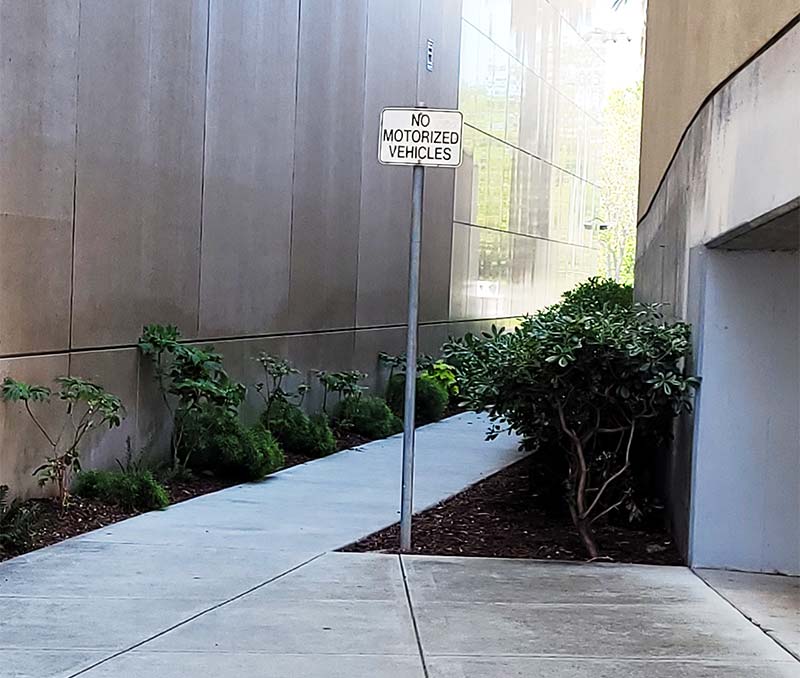
The narrow walkway from the back of the blue and white tent to a parking lot adjacent to the Children’s Bridge.
I was so excited to have discovered a portal through which we could get from the tent to the park (it couldn’t have been more than 500 yards) that I neglected to get GPS coordinates for the Bonus Cones. (That’s okay, though. The main thing is the Start and Goal.)
As mentioned, my first competing event was TableTop Navigation. TableTop Navigation was originally an HBRC event. In 2003, a group of us lamented the lack of building activity in the club. We noted that building coincided with “contests.” We had recently had a line-following and a maze-busting contest, but these involved fixtures that had to be set up and stored, and a contest meant that there were winners and losers. That’s when TABLEBot was born: a robot designed to survive, live, and play on a table … or pay the price.
The TABLEBot Challenge (TableTop Nav) is not a quantitative event. Time can be considered an element, but the judging is qualitative, with points given for looks, style, tech, method, and phases. Phase 1: Go from one end of the table to the other. Phase 2: Push a block off the edge of the table. Phase 3: Push the block into a shoebox mounted at the end of the table. There’s even a Phase 4 where one can fall off the table, but the robot still must work. For a complete list of the TABLEBot Challenge rules, go to http://robogames.net/rules/tablebot.php.
I entered TableTop Navigation with Buggy 3 and actually didn’t embarrass myself. I got two Phase 3s, one Phase 2, and zero Phase 4s.
Dave McCreary of New Age Aerial was our special guest judge. In the end, Mike Ferguson (USA) took Gold with his dual-purpose (it was also entered in Fire-Fighting) LiDAR-driven robot Sparky, while the Indonesian team DU114 took Silver and Bronze with XEROX-24 and ForK-R. Both robots had neat little arms that would grip the block and carry it to the box.

From left to right: Nawaf Anwar with MEROX-24, Taufig Nizar with ForK-R, and Mike Ferguson with Sparky.
When handing out the medals, I noticed something was missing … the plasma center! I asked Dave about it, and he said the manufacturer canceled the deal at the last minute, so we were left with “picture frame” medals until the plasma arrived.

This medal is on fire! If you happen to still have a plasma-less medal, refer to the source listed in the article.
Dave said he’d send them out when he got them. Everything in robotics is hard!
In the meantime, if you happen to have a plasma-less medal I have found a source for the plasma: https://www.amazon.com/LUCKYFISH-Portable-Response-Decoration-Activities/dp/B097HJ2RV4/.
Saturday, April 20, is all about Robo-Magellan. First, I must make the Robo-Magellan map.
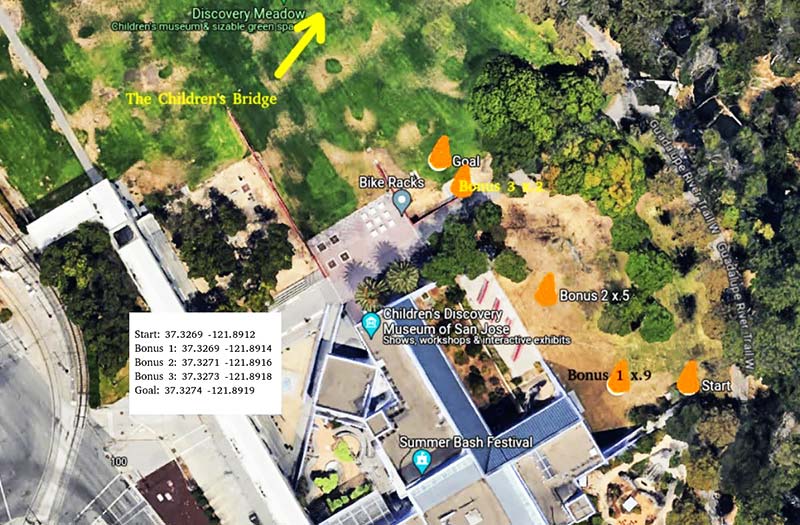
The RoboMagellan event map.
This map gets handed out 30 minutes before the event. We had the Start and Goal GPS coordinates but no Bonus Cones. I loaded the Google map onto my computer, pinpointed the Start GPS location and Goal, and then added Bonus Cones, yielding a fractional multiplier to decrease the robot runtime score.
For example, Bonus Cone #1 was easy and a .9 multiplier. If you touched this cone along the way, your time would decrease by 10%. Bonus Cone #2 was more difficult, with a .5 multiplier giving the competitor 50% off if it was touched along the way. Finally, Bonus Cone #3 was near the Goal but sandwiched between two bike racks. If you went for this difficult Cone, 90% of the time would be erased from your score.
However, should you not touch the Goal Cone, your score is the distance from the Goal (no timed score). The generally accepted strategy is to first get a straight run to the Goal (you get three attempts) to get a timed score, then on subsequent runs, get fancy and try and touch Bonus Cones along the way.
There were 13 entries. Nine showed up, seven got off the starting line, and two touched the Goal Cone. Nathan Lewis (Team Nathan) took Gold for the second year in a row with his modified RC Monster truck Kybernetes 2 in a straight (no Bonus Cone) run of 53 seconds.

Nathan Lewis touches the Goal (orange cone) in 53 seconds for the Gold!
On his second run, he touched Bonus Cone #2 (.5 multiplier) with a run time of 265 seconds, which yielded a score of 132.5 — not as good as the 53 second straight run.
SACbot from the team Bad Kitty of Mt. San Antonio College took the Silver Medal with a 95 second score (190 seconds x .5 Bonus Cone #1) on their third attempt.

Team SACBot from Mt. San Antonio College took Silver with their 95 second score in RoboMagellan.
They also touched the Goal Cone and a Bonus Cone on their first run for a 129 second score (144 seconds x .9 Bonus Cone #1).
Finally, BlueBot from Team RoboNerd took the Bronze (the happiest medal of all). BlueBot finished 10’ 10” from the Goal Cone.

RoboMagellan medal presentation (from left to right): Team SACBot’s Brian Erickson with their robot Bad Kitty for Silver; Nathan Lewis and his robot Kybernetes 2 for Gold; and Brian Erickson with his Bronze-winning robot, BlueBot.
Team RoboNerd had four entries, so I’m sure we’ll be seeing more of them in the future.
Finally, Sunday, April 21, the last day of RoboGames was upon us. I could now focus on and have some fun mapping and navigating with Smarty 2 (the Smart Table), my entry in Best of Show. Smarty is a ROS2-based robot (Robot Operating System) and part of a project I’m working on with a few other robot-building cohorts (Alan Federman, Ross Lunan, Phil McCrary, and Thomas Messerschmidt) called MockTurtleBot where we’ll be building TurtleBots (https://www.turtlebot.com/) in a variety of ways (Create 3, Botvac, or Roomba).

The map I created within which Smarty 2 was navigating.
Currently, I’m having issues with ROS2 mapping and navigating. Specifically, the /scan topic (LiDAR) disappears when I launch slam_toolbox or the Nav stack, but if I reset my network, the topic comes through; sometimes for a short while.
I also noticed more Wi-Fi delays (I brought my own gateway) when the ComBots robots were fighting. I assume this is due to radio interference. Regardless, when Dave came around to judge Best of Show, in an antithesis of Murphy’s Law, Smarty 2 was behaving, mapping, and navigating. I’d rather be lucky than good! Smarty 2 took Bronze in Best of Show.
In the end, the Gold medal for Best of Show was No Words, by Mohamed Elshazli from Egypt. The Silver medal went to Five Cent Yoda, by Micah “Chewy” Leibowitz from the USA, and the Bronze medal went to yours truly as mentioned.
Thomas Messerschmidt, founder of the Riverside Robotics Society, took Bronze in Art Bot-Kinetic with the beautiful and talented Betty9.

Betty9 by Thomas Messerschmidt performed her big hit, “I’m a Robot Girl” for a Bronze medal in the Art Bots-Kinetic competition.
Steven Nelson, long-time robot maker, took Bronze in Art-Bot Kinetic with a new and improved Beer2D2.

Steven Nelson (a regular at RoboGames) with his Beer2D2. He took Bronze in Art Bots-Kinetic.
Before leaving California, I dropped in on InOrbit in Mountain View. It’s the robot space where they’re developing software for robot operations for various purposes: cleaning, warehousing, delivery, security, etc. They also host the HomeBrew Robotics Club on the last Wednesdays of each month. For more info, on InOrbit, go to https://www.inorbit.ai/.
Last year, John and I referred to RoboGames as a fairy tale experience, as we both got Bronze medals (me for Tabletop Navigation and John for Best of Show).

Best of Show winners: Gold to No Words, Mohamed Eishazi from Egypt; Silver to Five Cent Yoda, Micah “Chew” Leibowitz from the US; and Bronze to Camp Peavy from the US.
Although John didn’t medal this year, it was still a fairy tale experience. RoboGames is a unique group of individuals who visualize a world where mechanical entities do the dirty, dull, and dangerous work. Not only that, robots provide friendship, companionship, and potential unlike any other opportunity.
Many people put a lot of time, energy, and effort into this endeavor. Sometimes it works out, and sometimes it doesn’t, but without a deadline, nothing happens. Thanks for all the deadlines, Dave! Long live RoboGames! SV
Article Comments